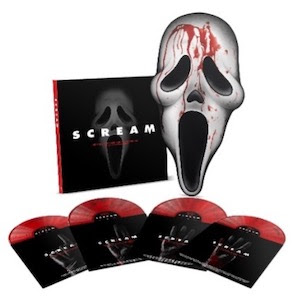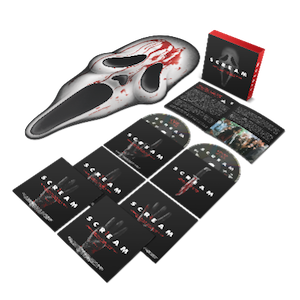January 7, 2022
Varèse Sarabande Celebrates the Return of SCREAM With Bonus-Filled Collection Of Marco Beltrami’s Music From First Four Films with 4-LP and 6-CD sets
As the latest installment of SCREAM lands in theaters this winter, Varèse Sarabande revisits Marco Beltrami’s masterful scores from the horror franchise’s first four films with SCREAM: Original Motion Picture Soundtracks.
The 4-LP set—pressed on blood-red vinyl with black smoke swirls—dedicates a full album to each film and includes two hours of unreleased material. In all retail stores June 10, and available for pre-order today, the collection is housed in a unique jacket, which folds out into a 3’ x 2’ Ghostface mask from VareseSarabande.com and Intl.VareseSarabande.com. For fans seeking additional content, the 6-CD and digital editions (both available today) offer each film’s score in its entirety, plus more than four hours of unreleased music, previously unreleased demos, cues, and alternate takes. The CD box set is available exclusively on VareseSarabande.com and Intl.VareseSarabande.com, limited to 1,800 units.
Both the CD and vinyl versions feature new, in-depth liner notes from film music journalist and author, Jim Lochner.
The original SCREAM – which went on to become one of the highest-grossing horror films of all-time – centers around Sidney Prescott (Campbell), a high school student in the fictional town of Woodsboro, CA, who is targeted by a masked serial killer, known as “Ghostface.” Over the following sequels, Prescott continues to face new pursuers, who all assume the Ghostface identity. Underscoring the action for the first four SCREAMfilms is an engaging score by Mario Beltrami.
SCREAM was not only Beltrami’s big break into Hollywood, but it also served as his introduction to the genre. “It was a little bit strange for me because…I’d never seen a horror movie,” Beltrami told Lochner. “There are a lot of references to other horror movies, which I didn’t understand at all, so I felt a little uncomfortable.” Nevertheless, Craven was impressed with Beltrami’s work and took a chance on the young composer. SCREAM would mark the first of seven collaborations between the two men.
Beltrami’s first project was the film’s opening scene. “It had this over-the-top, almost operatic nature to it…. It was very dynamic. That was the mode I followed with the rest of the score,” he recalls, adding that his unfamiliarity with the genre played to his advantage. “I viewed the movie from a very innocent standpoint, taking the images not in any jaded way but truly petrified.”
Beltrami, who recalls that Craven was “very patient with me,” recorded the SCREAM score on a limited budget. This led to plenty of ingenuity in the studio—working with smaller combinations of musicians, in lieu of a full orchestra, and bolstering recordings with synthesizers and stock library samples. Among the most memorable compositions from this film were two musical themes that Beltrami revisited throughout his work with the franchise. They include Sidney’s theme (“Sidney Wants It”) and, as Lochner notes, a “Spaghetti Western sound that…ultimately evolved into a more prominent guitar theme [“Dewey’s Theme”] for Dewey (Arquette) in the sequels.”
The success of the first SCREAM afforded Beltrami a broader range of musical tools for the sequel, 1998’s SCREAM2. In addition to hiring a full orchestra and choir, the composer experimented with electronic elements to create unique musical textures throughout the score. By now, Beltrami was more comfortable with the genre, which revealed itself in his use of musical trickery. “I learned to play with the audience expectation by using sound to scare,” he explains. “If you’re expecting a scare at a certain point, you don’t do it then. You do it when the audience lets down their guard. You put the sting where they’re not expecting it and it throws everybody off.”
When SCREAM3 arrived in 2000, Beltrami was working with a 95-piece orchestra and a 30-person choir. He also was fully entrenched in the SCREAMuniverse. “That whole searching process, that whole Sturm und Drang of trying to figure out what the movie was got so much easier… I could just write the cues and not worry about it.” But SCREAM 4, which dropped a decade later, found Beltrami, Craven, and Williamson moving in a new direction. This time, the plot reflected a significant cultural shift, following the rise of social media, smartphones, and online culture. “Since SCREAM 4 was intended for a new era 10 years removed from the original trilogy, I wanted to sonically set it apart from the over-the-top polish and orchestral extravagance of the previous few entries,” explains Beltrami. “I thought it would be more interesting to aim for a more gritty, rough-around-the-edges, scaled-back sound, while still retaining the familiar themes and overall sound of the franchise.”
As Lochner notes, it was SCREAM that started it all for Beltrami, introducing him “to the craziness of…composing for big Hollywood films.” Since then, the Academy Award®-nominated composer has scored more than a hundred films, TV shows, and video games. But SCREAM will always hold a special place in the composer’s heart—particularly because it established his long-running creative partnership and friendship with Craven, who died in 2015 at the age of 76. “Wes really taught me a lot about how I score movies,” shares Beltrami. “I really treasured the relationship. It was more than just a work relationship. I felt like he nurtured my career.”
But that isn’t the end of the SCREAMstory. While rumors of a fifth installment pervaded Hollywood for several years, it wasn’t until 2019 that the movie began to take shape. Now, on January 14, the latest edition of SCREAM arrives in theaters and finds Campbell, Cox, and Arquette reprising their roles, as a new killer targets a group of teenagers in Woodsboro, which features a brand-new score from the Emmy®-nominated composer, Brian Tyler (CRAZY RICH ASIANS, AVENGERS: AGE OF ULTRON, READY OR NOT). Varèse Sarabande is pleased to partner with Paramount Pictures to release the new film’s official score in 14-track vinyl, expanded 24-track CD, and digital versions – see details here.






